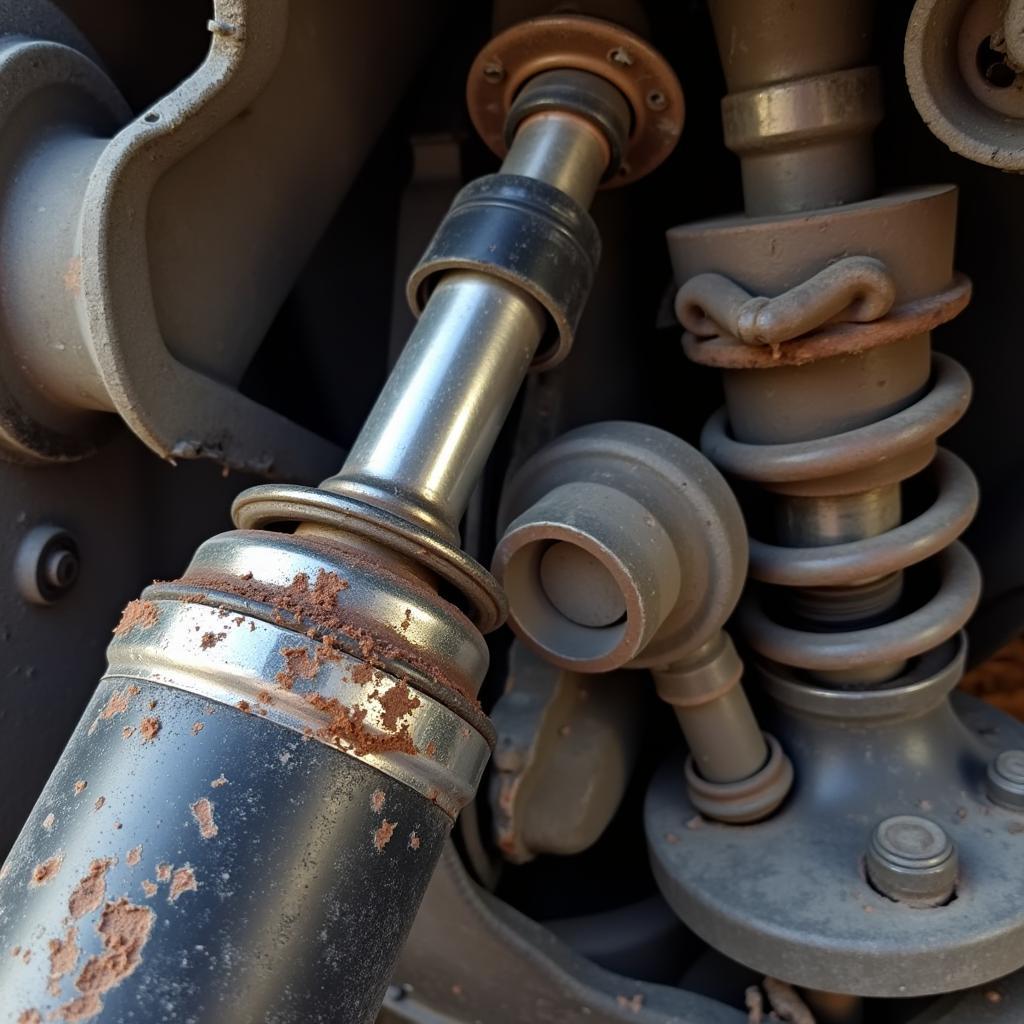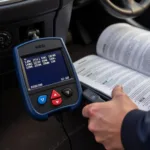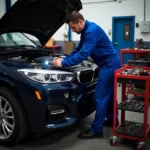Car suspension problems are a common occurrence that can lead to a bumpy, uncomfortable, and even dangerous ride. Understanding the components involved and the steps for repair can save you money and keep your vehicle running smoothly.
Identifying Suspension Problems: What to Look For
Before diving into repairs, it’s crucial to pinpoint the source of the issue. Here are some tell-tale signs of a failing suspension:
- Uneven tire wear: Excessive wear on one side of the tire can indicate a problem with the alignment, often caused by worn suspension components.
- Bouncing or swaying while driving: If your car bounces excessively after hitting a bump or sways significantly when turning, it’s a strong sign of a suspension problem.
- Nosediving or squatting: Does your car dip forward when braking (nosediving) or squat in the rear when accelerating? This could signal worn-out shocks or struts.
- Pulling to one side: While this can be caused by tire issues, it’s often a symptom of a suspension problem, particularly if the pulling worsens when braking.
- Knocking or clunking noises: Unusual noises, especially when going over bumps or turning, often originate from worn-out bushings, ball joints, or other suspension parts.
 Worn Suspension Components
Worn Suspension Components
Common Car Suspension Components and Their Functions
Your car’s suspension is a complex system with several interacting parts. Here are some of the most crucial components:
- Shocks and Struts: These absorb impacts from bumps and dips, ensuring a smoother ride and maintaining tire contact with the road.
- Springs: Coil or leaf springs support the vehicle’s weight and work with the shocks to absorb impacts.
- Control Arms: These connect the wheels to the frame and allow for controlled movement.
- Ball Joints: These pivotal joints allow the wheels to move up and down and turn simultaneously.
- Bushings: Rubber or polyurethane components that isolate and reduce noise and vibration between suspension parts.
How to Repair Car Suspension: A Step-by-Step Guide
While repairing car suspension can be complex and is best left to professionals for safety reasons, understanding the basic steps can be helpful.
1. Diagnosing the Problem:
- Thoroughly inspect the entire suspension system, looking for visible signs of wear and tear, leaks, or damage.
- Pay attention to unusual noises and vibrations during a test drive.
2. Gathering Necessary Tools and Parts:
- Once the issue is identified, gather the specific tools required for the repair, including wrenches, sockets, jacks, and safety equipment.
- Purchase high-quality replacement parts compatible with your car model.
3. Safely Lifting and Securing the Vehicle:
- Use a sturdy jack to lift the vehicle from the designated jacking points mentioned in your car’s manual.
- Secure the vehicle on jack stands for safety before working underneath it.
4. Removing the Damaged Components:
- Carefully follow the instructions in your car’s repair manual to remove the damaged suspension components.
- Label any disconnected parts or bolts to ensure proper reassembly.
5. Installing the New Parts:
- Install the new suspension components, ensuring they are correctly aligned and secured.
- Tighten all bolts to the manufacturer’s specifications using a torque wrench.
6. Lowering the Vehicle and Performing a Wheel Alignment:
- Carefully lower the vehicle from the jack stands.
- Get a professional wheel alignment to ensure your car drives straight and tires wear evenly.
Is It Possible to Repair Car Suspension Myself?
While some minor suspension repairs can be tackled by experienced DIYers, it’s generally recommended to leave complex suspension work to certified mechanics.
“Suspension repairs involve critical safety components and require specialized tools and knowledge,” says John Miller, a seasoned automotive engineer. “Incorrect repairs can compromise your vehicle’s handling and put you at risk.”
When to Seek Professional Help for Car Suspension Repair
If you experience any of the following, it’s best to seek professional help immediately:
- Severe suspension damage: Significant damage from an accident or collision requires professional assessment and repair.
- Lack of experience or tools: If you’re not comfortable working on your car’s suspension or lack the necessary tools, it’s best to seek professional assistance.
- Safety concerns: Your safety is paramount. If you have any doubts or concerns about performing the repairs yourself, err on the side of caution and consult a professional.
Conclusion
Understanding How To Repair Suspension Of Car is essential for ensuring a safe and comfortable ride. While some repairs might be manageable for DIY enthusiasts, seeking professional help is crucial for complex issues or when safety is a concern. Remember, regular maintenance and timely repairs can extend your suspension’s lifespan and contribute to a smoother driving experience.
FAQs
1. How often should I get my car’s suspension checked?
It’s recommended to have your suspension inspected annually or every 50,000 miles, whichever comes first.
2. Can I drive with a broken suspension spring?
No, driving with a broken suspension spring is extremely dangerous and can lead to loss of control of your vehicle.
3. How much does it cost to replace a car suspension?
The cost varies depending on the car make and model and the extent of the repairs. On average, expect to pay between $400 and $1,000 for suspension repairs.
4. How long does it take to repair car suspension?
The repair time depends on the complexity of the issue. Simple repairs might take a few hours, while more involved repairs could take a day or longer.
5. How can I make my car suspension last longer?
Regularly inspecting your suspension, driving carefully over bumps, and addressing any issues promptly can significantly extend its lifespan.
For more insights on car maintenance and repairs, explore our related articles:
- Is it possible to repair car suspension
- How to repair remote control car
- How to repair broken rc car 4×4
- How to do car repair
- How to make remote control car repair running cars
Need assistance with your car’s suspension or other automotive needs? Contact our team 24/7 via WhatsApp: +1(641)206-8880 or Email: [email protected]. Our experienced technicians are ready to help!


